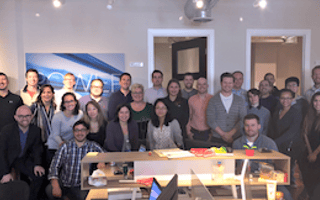
Slow-moving merchandise presents a problem for any retailer, but in the automotive industry, where each unit is literally as big as your car, keeping that inventory moving is absolutely vital.
LotLinx, a Chicago-based automotive adtech startup, uses hyper-targeted online marketing to help car dealers make that happen.
“There’s a shopper out there for every car,” said co-founder and CEO Denise Chudy. “It’s up to us to go find that shopper.”
Part of the original management team at Cars.com, Chudy went on to launch the automotive vertical at Google in 2003 while skepticism still reigned about consumer appetite for online car shopping. Her newest venture is a response of sorts to the changing habits of online consumers.
“We realized that people were not spending as much time on one site as they used to,” said Chudy. “Instead, they were snacking across the internet.”
So rather than attempting to drive traffic to a centralized listing platform, which would be expensive to build and maintain, LotLinx takes an omni-channel marketing approach. The company distributes a dealer’s internal listings across automotive sites, Facebook and other highly trafficked websites, specifically targeting users who live close to the dealership.
In other words: they’re bringing cars to customers, rather than the other way around.
Since LotLinx sends shoppers directly to specific vehicle listings on a dealership’s website, the first step of working with a client is getting to understand their inventory.
A typical auto dealer has around 200 cars in their lot. Some cars have a strong natural audience, with people seeking out a dealership with those specific cars in mind. Other cars are considered solid alternatives, drawing a moderate amount of attention from would-be buyers. But there’s also a third category: overlooked cars, which hardly receive any attention at all.
Depending on the dealer’s needs, LotLinx can focus its efforts on directing traffic to fast-moving cars that accelerate the number of total sales, high-margin vehicles that improve the bottom line, or overlooked cars that may need an extra boost to find the right buyer.
Since its fee structure is based on performance, LotLinx collects data down to the level of individual vehicles. The company draws on that data to constantly fine-tune its targeting.
“We like to consider ourselves an insight machine,” said Chudy. “Every day we’re learning a lot about how people shop for cars and which cars move in which markets, all the way down to the make and model level, pricing and how many pictures you have.”
Launched in 2012, LotLinx started gaining traction in 2014, attracting car dealership clients by the hundreds. The company also works directly with some auto manufacturers.
Chudy, who left LotLinx for a while to take a senior role at The Weather Channel, attributes part of the sudden takeoff to auto dealerships getting more serious about digital marketing. And this year, the company hit another growth spurt after shifting its focus toward marketing slow-moving inventory.
The home of companies like Cars.com, DRIVIN and BMW Technology Corporation, Chicago has made a name for itself as a hub for automotive technology. Chudy thinks Cars.com’s early success helped lay the foundation for what has become a quite thriving ecosystem.
“You had a whole industry of folks from Cars.com who left to either start their own thing or work at another company,” she said, adding that . “Chicago is a great automotive market, but also a great pivot for traveling across the United States. You can get just about anywhere with a direct flight.”
Image via LotLinx.
What's your company's story? Send us an email or tweet us @BuiltInChicago






